Invisalign – West Jordan, UT
The Clear Path to a Straight Smile
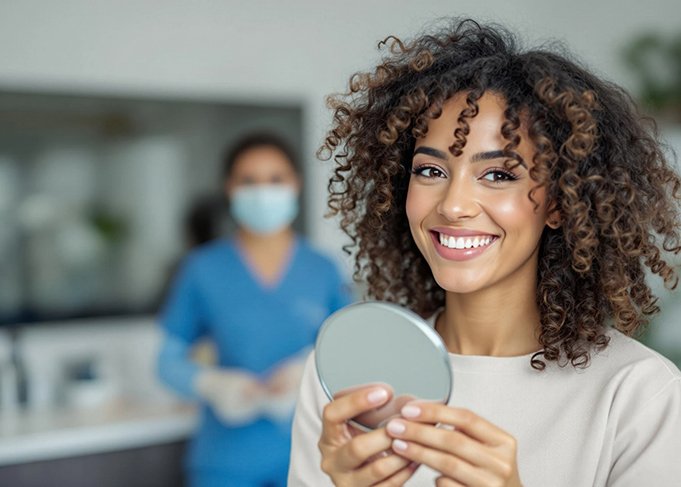
For decades, metal braces were the go-to solution. Now, there is an equally as effective alternative that’s considerably more discreet: Invisalign. So, if you were told in the past that traditional orthodontics were the only option for you, that may not be the case anymore! If you want to find out if you’re a candidate for clear aligner treatment, then schedule a consultation at our West Jordan dental office. You can also read on to learn more, starting with an overview of the teeth-straightening process.
Why Choose Frandsen Dental of West Jordan for Invisalign?
- Office Outfitted with the Latest Technology
- Bilingual Dental Team
- Multiple Financial Solutions Available
How Invisalign Works
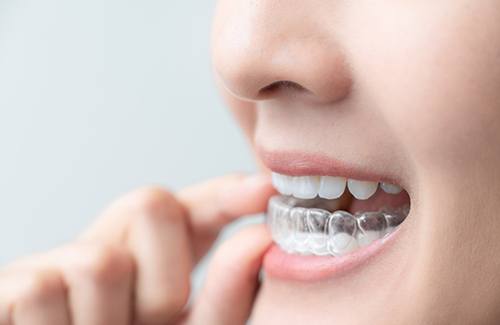
The first step of the Invisalign process is the consultation, which is when we will learn all about your dental needs and determine if you’re a good candidate. If you are, then we will take impressions of your teeth so a custom series of clear aligners can be made. Each one is designed to move your teeth a step closer to their properly aligned positions, and you need to keep them on for a minimum of 20 hours a day to stay on-track with your treatment plan. Every 7-14 days, you’ll progress to the next set in the series and, before you know it, you’ll have the straight smile you’ve always wanted!
Who Invisalign Can Help
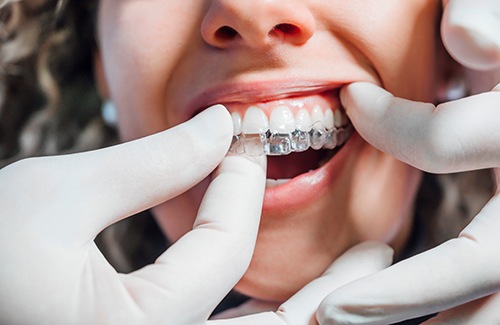
Good news: Invisalign is quite versatile. So, if you are ready to leave overcrowding and other common orthodontic problems in the past, don’t hesitate to schedule a consultation with us. In the meantime, you can read on to learn more about who Invisalign can help.
Crowded Teeth
If your teeth overlap, food particles and other debris can easily get trapped inside. Don’t worry though – Invisalign clear aligners can guide your teeth into their properly aligned positions, improving your oral health and self-esteem in the process.
Gaps Between Teeth
Are your teeth spaced out? If so, you’re at an increased risk of experiencing common oral health problems, like cavities. That’s why we recommend exploring your treatment options, like Invisalign. If you’re a candidate for clear aligners, then we can gently close the gaps without the metal.
Bite Alignment
One misconception about Invisalign is that it can’t correct common bite problems, like overbites. That’s not the case! In fact, when used in tandem with rubber bands and other orthodontic accessories, clear aligners can correct underbites, crossbites, and open bites as well.
Benefits of Invisalign

If you’re trying to decide whether Invisalign is the right choice for you, it often helps to consider the many benefits associated with the treatment. Because Invisalign utilizes removable clear aligners instead of brackets and wires, it comes with quite a few advantages that you wouldn’t be able to enjoy with traditional braces. Here are just some of the reasons why Invisalign can be an excellent solution for those with crooked teeth or misaligned bites.
Image-Friendly Aligners
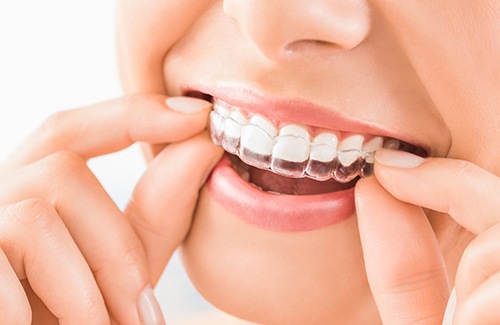
Many adults are reluctant to get traditional braces because they’re worried about the impact that the brackets and wires could have on their appearance. With Invisalign, this isn’t an issue; each aligner is made out of clear plastic, so while they’re easy enough to see on their own, they become virtually unnoticeable when worn over the teeth. This makes them far more discreet, making it easier to show off your smile with confidence throughout every step of your treatment.
Comfortable Material
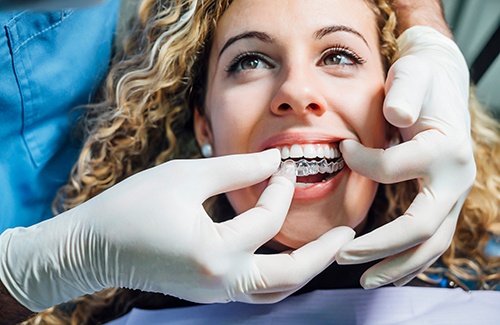
The plastic that Invisalign aligners are made out of is very smooth and is quite gentle on the soft tissues inside your mouth. On top of that, the aligners are all carefully customized with your unique smile in mind. As a result, they tend to be significantly more comfortable than metal brackets and wires, and you won’t have to worry about them irritating your gums or the inside of your cheek.
A More Varied Diet

With traditional braces, you need to avoid certain foods altogether so that they don’t damage your brackets and wires. In contrast, Invisalign doesn’t come with any notable diet restrictions. The aligners can simply be taken out of your mouth when it’s time to eat, meaning you can enjoy all of your favorite foods without putting your orthodontic appliances at risk.
An Easier Oral Hygiene Routine
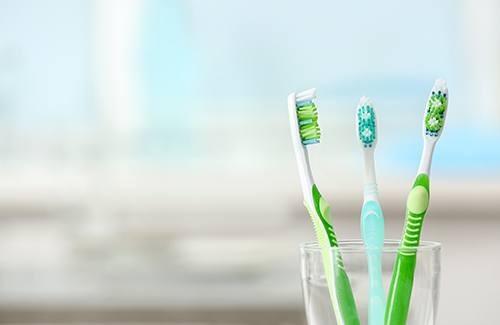
The removable nature of Invisalign will make it much easier to maintain excellent oral hygiene throughout your orthodontic treatment. Instead of having to learn how to clean around brackets and wires, you will be able to brush and floss your teeth normally. The aligners themselves are also easy to take care of; you can simply brush them regularly with a soft-bristled toothbrush and a nonabrasive cleaning material.
Fewer Follow-Ups
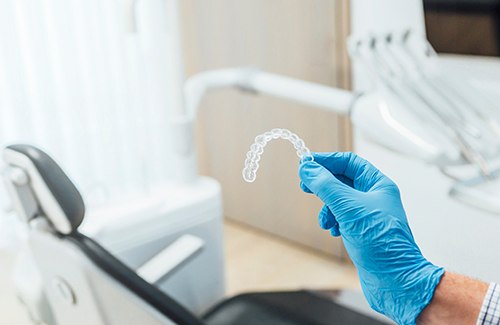
With traditional braces, you may need to have a progress check performed as often as every 4 weeks. In comparison, Invisalign only requires you to come into our office every 6 to 8 weeks. This means you won’t need to make room in your schedule for as many follow-up appointments.
Shorter Average Treatment Time
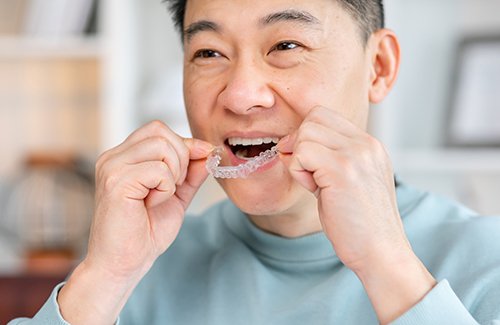
The average Invisalign treatment takes somewhere between 12 to 18 months. In comparison, it’s not unusual for a treatment involving traditional braces to last for two or three years. As such, when it comes to treating mild or moderate alignment issues, Invisalign often yields faster results.
Living with Invisalign Aligners

Curious how your life will change once you begin your clear aligner treatment? If so, you’re in the right place! In this next section, we’re covering everything you need to know, including how to take care of your aligners so stubborn stains and unpleasant smells don’t surface.
Wearing Your Trays
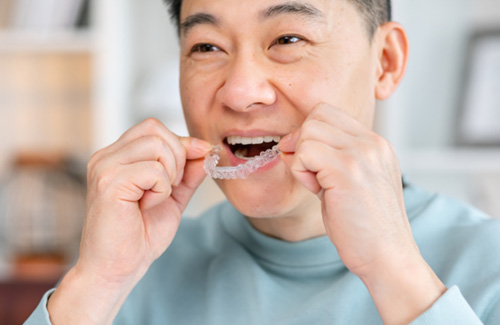
Of course, one of the biggest adjustments is actually wearing the aligners. To stay on track with your treatment plan, we recommend keeping them on for a minimum of 20 hours a day. At first, that might seem easy, but you’ll quickly realize how little aligner-free time that is. The best thing to do is get in the habit of only taking them out when it’s absolutely necessary. If needed, you can use the stopwatch on your phone as a guide, too!
Cleaning Your Aligners
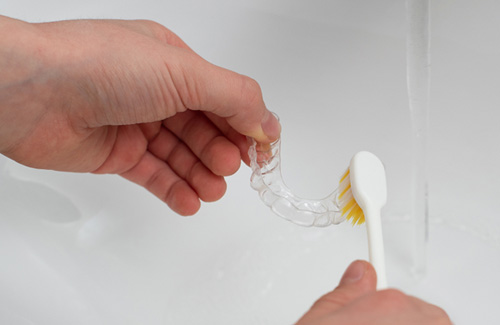
Good news: you don’t need to buy any expensive cleaning products to take good care of your aligners. In fact, there’s a good chance you already have the three things you need: clean water, a soft-bristled toothbrush, and clear, mild dishwashing liquid. If you’d like, you can also soak your trays in a dentist-recommended cleaning solution for 15 minutes or so each day. Just make sure to do so when you’re already planning on having them out, like while you eat dinner.
Eating & Drinking

Since Invisalign aligners are removable, you don’t need to completely change your diet during your orthodontic treatment. You do, however, need to limit your intake of extremely sugary and crunchy foods since dental trouble can lead to significant delays. Simultaneously, focus on incorporating more nutrient-dense foods into your meals, like plain yogurt, cooked carrots, steamed broccoli, and cottage cheese.
Losing or Damaging a Tray

Patients are often tempted to find a solution on their own to skirt judgment, such as using superglue to repair their aligners. However, doing so can lead to several problems, including significant treatment plan delays. That’s why we always recommend calling us! That way, a helpful member of our team can determine the best way to proceed, like wearing the previous set until a replacement arrives.
Attending Progress Visits

Another important component of life with Invisalign is attending the progress visits. At each one, we will take new scans of your teeth to monitor their movement and determine if you are on track with your treatment plan. If you are, then there’s a good chance you’ll be in and out of our office in less than 30 minutes. If you aren’t, then we can quickly pinpoint why that is and make the necessary adjustments.
Important reminder: Make sure to wear your aligners to each visit, even if you are moving on to the next set in the series shortly after.
How Much Does Invisalign Cost?
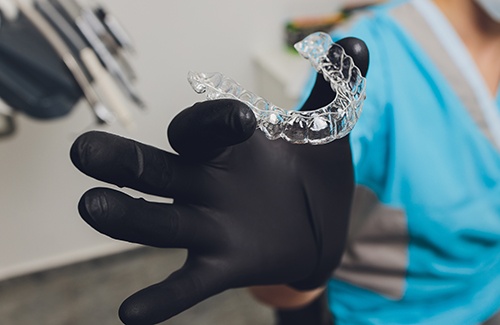
The cost of your Invisalign treatment will depend on a few factors, including the severity of your misalignment and how many trays need to be made. Rest assured, we will provide you with an estimate of the price at your visit. We will also discuss the financial solutions available, including dental insurance and Cherry financing, so handling the financial side of your care isn’t stressful.
Invisalign FAQs
What Does Invisalign Look Like?
Unlike standard orthodontics, which relies on dark metal brackets and wires, Invisalign utilizes transparent plastic trays that fit snugly over your arches to shift your teeth gently. They’re considered more discreet than traditional braces because they’re completely clear and allow your natural enamel to shine through.
Some patients require buttons, attachments, elastics, or other accessories to complete their treatment, which can sometimes be more visible. However, in many cases, these supplies can also be clear or tooth-colored to avoid drawing unwanted attention to your smile.
Does Invisalign Hurt?
It’s natural to wonder whether Invisalign will hurt, and the truth is that any treatment that applies enough pressure to your teeth to move them has the potential to be painful. This is especially true when you first start wearing a new set of trays, because it can take your teeth and gums some time to adjust to the updated dimensions.
With that said, many patients in West Jordan choose Invisalign because it’s considered a more comfortable and discreet alternative to standard braces. For instance, the smooth plastic material won’t cut the tender tissues inside your mouth like the sharp corners and ends of metal brackets and wires.
How Long Does Invisalign Usually Take?
Another reason that this method continues to gain popularity as a clear alternative to traditional orthodontics is that it’s often the faster option. Most patients finish their treatment between 12 and 18 months, though there may be exceptions.
That might seem like a long time on paper, but braces tend to take 24+ months to do the same work. If you’re concerned that your Invisalign treatment might take too long, the best way to remain on track is to wear your trays for the designated 20 to 22 hours daily to prevent your teeth from reverting to their previous places.
What Happens After Invisalign?
Your teeth are connected by ligaments and tissues with a capacity for movement, but which also have a “muscle memory”. Unfortunately, they’re prone to shifting back out of alignment, especially in the period immediately following the completion of your orthodontic service.
As a result, our team will likely provide a custom-fitted retainer for you to wear. These oral appliances don’t exert enough force to move your teeth, but they do ensure that everything remains in its current position to prevent potential relapse. We’ll provide instructions so you know how long you’ll need to wear it to maintain your recently straightened smile.
